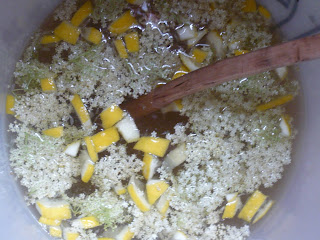In an expression of culinary nous, the Elderflower and Gooseberry Seasons just overlap, offering myriad excuses to combine the tart berries with the diaphanous sweet-scented flowers. Be it in an Elderflower and Gooseberry Fool, a Champagne, a Marmalade, or as here in Vodka.
Elderflowers are best picked on a bright early morning when the volatile oils are rising. Choose unblemished flowers in blossom. ‘tis the season, and the season is short, with the current heat and winds the flowers will soon be over. So, on a spritely Sunday morning - to pick!
A simple recipe for Elderflower Champagne, using the wild yeasts gathered on the blossom, tried and tested in several gallon quantities, by Christophe, brewer extraordinaire on Macalla Ecofarm, Clare Island, is the following:
5 heads of Elderflower (shaken for bugs) ; 1 Lemon (very finely sliced); 500g Sugar, 1 tbsp Cider Vinegar (White Wine if to hand), 5lt Water.
Put the lot in a fermenting bucket, stir, cover with a tea-towel, and leave to ferment stirring regularly to dissolve the sugar, for three to four days, depending on the rate of fermentation. Then bottle in sterilised screw-top bottles and keep for a month at least before drinking.
Put the lot in a fermenting bucket
A momentary panic set in here, when my own batch failed to start fermenting. Perhaps due to the temperature of this house, where even my Sourdough takes a full twenty-four hours as opposed to the usual ten.
The unsettling time is now over, a flash of sunshine had the brew in burgeoning effervescence. And yesterday afternoon, smartly, for over fermenting in air can turn the drink acrid, the Champagne was strained through muslin and bottled using a siphon. Already a glorious, if slightly sweet, sparkling Elderflower wine, the in-bottle fermentation will allow the flavour to mature and, I believe, ferment the remaining sugars.
A couple of litres was kept aside to ferment for Wine in an airlocked Demijohn... As I stacked the many bottles into the Shed, alongside the other pickles and preserves, and saw the Garden Shed/Pantry 'plenishing I was reminded of a Macalla Farm adage: We may have holes in our clothes, but we are rich...
Inspired by With Knife and Fork’s “Elderflower Rush”, and having picked a lot of gooseberries to encourage better fruiting, I decided to attempt Elderflower and Gooseberry Rush:
Top and tail 200g Gooseberries and pierce. Add these, 5 heads of Elderflower, 250g of Sugar and 70cl Vodka to a Demijohn. Shake well to help dissolve sugar. Store in a cool dark place, shaking regularly for the first month. Strain and Bottle. Mature in bottle for a further month.
Pickled Gooseberries
The River Cottage Preserves Handbook, a handy-sized guide to the multitudinous means of preserving, lured me, and with it in hand I soon found myself pickling the remaining Gooseberries. Sadly, as is perhaps painfully evident as I write, I am far from adept at following recipes. The Pickled Gooseberries turned out quite other to the gleaming tender pink/green berries I had envisaged bedecked in a rich gloopy coating of cinnamon-spiced vinegary syrup – No! Mine were a rather watery hotchpotch of Gooseberry seeds and skin in various merging pallid tones.
"a rather watery hotchpotch of Gooseberry seeds and skin in various merging pallid tones"
From this description, I know you cannot but wish to get hold of my own variation on the recipe. I thus include it herewith:
Top and tail 200g Gooseberries (pert, green).
Put 150ml Cider Vinegar and 150ml Cider, Cinnamon, Cloves, Root Ginger in a pan. Boil. Simmer for 5 mins. Leave to cool. Once cool, strain and place Gooseberries and ¼ Red onion thinly sliced in the mixture, 2tsp Mustard Seeds and a Chilli. Heat slowly without bringing to the boil (I fear I cooked my own too quick, encouraging the Gooseberries to fall to pieces). Simmer very very slowly until Gooseberries tender. Strain, keeping liquid. Pack fruits into warm, sterilised jars. Meanwhile add 200g sugar to liquid and reduce to a thick syrup. Cover the Gooseberries in Syrup. Seal and keep for a month before eating, allowing the Gooseberries to fully pickle.
Prior to making, I had imagined the berries served with a Camembert or a Pyrenean Ewes Cheese. However, at the result, I think this would be more appropriate served with Mackerel in a pickled variation on the Maquereau aux Groseilles theme.



No comments:
Post a Comment
Your thoughts...